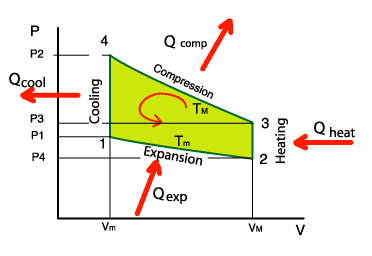
Stirling engine
Ce site appartient au réseau de sites relatifs aux moteurs à air chaud ou moteurs à apport de chaleur externe

Ce site appartient au réseau de sites relatifs aux moteurs à air chaud ou moteurs à apport de chaleur externe
The Stirling engine is a reversible engine. In this case, it is necessary to provide it mechanical
energy. The interest of such an operation is that one takes calories from the cold source to transfer them
to the hot source. It is the principle of the refrigerator or of the heat pump.
In cryogenic industry, this property is for a long time exploited to produce extreme cold. Thus, gases
are liquified.
One can also imagine to take calories in a phreatic nappe to introduce them in the cozy atmosphere of a
dwelling in winter.

On the diagram opposite, one sees the 4 phases of the cycle of Stirling in such a use:
- from 1 to 2 : expansion at constant temperature. This requires to take calories in the cold source.
- from 2 to 3 : one heats gas from Tm to TM in the regenerator.
- from 3 to 4 : one compresses gas at constant temperature. This requires to cool it and to provide calories
to the hot source.
- from 4 to 1 : one cools gas in the regenerator.
The surface delimited by the cycle (in green) is representative of the energy which one must provide to
the device.
One defines the heat pump COP (coefficient of performance) as the ratio of the recovered heat on the provided mechanical energy. Now, one observes the diagram above:

By looking at equations of mechanical efficiency (see: The Pressure-Volume diagram and the cycle efficiency) :

The COP is the reverse of the efficiency of an engine which would have a similar diagram.
Let us take a Stirling engine with a hot source of 50°C or 323 K and a cold source of 5°C or 278 K. The
theoretical efficiency would be 14%.
Now, let us take a heat pump having the same hot and cold sources (for example: water in house radiators
with 50°C, and ground water with 5°C), its theoretical COP would be 7!
In reality, the COP would be lower because of the various losses, capacities of exchange and frictions.
But nevertheless…
This site was created and is maintained by Pierre Gras.
Thank you with all the people who contributed their shares: articles, photographs, videos, worksheets.
The author is opened with any suggestion allowing to improve this site for happiness of everybody. Finally, a big
thank you to Robert Stirling !
"stirlinengine.fr" site by Pierre Gras is licensed under a
Creative Commons License
 .
.
This site meets XHTML and CSS standards. To get the best, use a browser such as Firefox, Chrome, Safari, Opera... they also adhere to these standards.